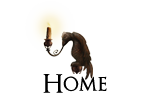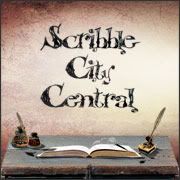Scribble City Central's thirty-seventh Fantabulous Friday comes from Katherine Langrish, a writer whose work has often been compared to that of Alan Garner. That's a pretty fine accolade, and, in my opinion, well-deserved. Katherine has an innate knowledge about the ins and outs of folk and fairytale - but more than that, she is someone who will delve down into the deep earth at the hidden roots of a story in order to bring its true essence up to the light of day. For her, I think, the devil is in the detail, and it is in that very precise pinning down of a sound or a feeling with just the right word or phrase that her writing genius lies.
Her latest book, Forsaken, tells the story of a mer-child, abandoned by her human mother, and is a perfect example of this. It is uncomfortable to read how Mara's 'delicate tail fins became tattered and curled', how the sun blasted her so that her skin 'would soon begin to crackle like seaweed left on the beach'. But can't you just see that mer-child now, feel her pain, just from those few words? I can.
Katherine is also involved as an editor in the just-launched journal of brand-new folk and fairytale writing, Unsettling Wonder, and I'm much looking forward to reading the first offerings from that when they arrive. Do have a look at their website, HERE.
I interviewed Katherine a little while ago, about her wonderful Troll trilogy, West of the Moon, and you can read that interview HERE. Right now, though, I'm quite certain there's no one better qualified than Katherine to talk about:
T for Troll
Mischief-makers of the Mountains
 |
| Photo of Katherine Langrish by Helen Giles |
KL: I probably first met trolls when I read The Hobbit in the 1960’s. Those particular trolls are called Bert, Tom, and Bill Huggins; they talk Mockney: and while I don’t know whether Tolkien consciously intended it, they are quite obviously caricature working-class characters who present a proletarian threat (violence; hunger) to Bilbo’s comfortable bourgeois identity. This being the 1930’s, it’s not surprising that the low-class trolls are stupid and easily tricked by upper-class, donnish Gandalf into wasting so much time deciding whether to murder Bilbo and his friends by squashing them, roasting them or mincing them, that they’re finally overtaken by dawn and turn to stone.
Trolls get a bad press. Cave trolls in The Lord of the Rings are even more stupid and violent than those of The Hobbit (but no longer comic); while the trolls in J.K. Rowling’s Harry Potter series are giant Fungus-the-Bogeyman type creatures with sloping foreheads and green snot dripping from their noses. Well, even though it’s quite true that some trolls in traditional tales are large and stupid and turn to stone at sunrise, the race of trolls in general is a great deal more interesting and varied than this!
To begin with, the word ‘troll’ in Norway, Iceland, Denmark and Sweden isn’t all that specific. It’s much more like the word ‘elf’ in English – which (if you discount Tolkien again; he really has a lot to answer for!) used to mean almost anything from a brownie to the Queen of the Seelie Court. In Scandinavia, a troll can be anything from a giant, to something human sized, down to quite small creatures.
Hans Christian Andersen wrote a wonderful story called The Troll Hill or The Elf Mound, depending on the translation. Its original Danish title is ‘Elverhøi’: but as the inhabitants of the fairy hill bustle to make preparations for the wedding of the king’s two daughters with two sons of the Troll King of Norway, it’s clear that elves and trolls are much alike:
There he was: the troll king from Dovre! His crown was made of ice and polished pine cones. He was wearing a bearskin coat and heavy boots. His sons, on the other hand, were lightly dressed: their collars were open, and they weren’t wearing suspenders. They were two big strapping fellows.
“Is this a hill?” laughed the younger one. “In Norway we would call it a hole in the ground.”
It’s a funny, eerie story, as well as a light satire on the Norwegian nationalist movement. It influenced Henrik Ibsen’s play Peer Gynt, in which the eponymous hero meets a green troll woman and has a son by her, and narrowly escapes being turned into a troll himself in ‘the Hall of the Mountain King’. I paid tribute to both with my own version of a troll wedding in my first book Troll Fell.
Icelandic trolls often tend to be giant-sized, like Hallgerdur of the mountain Bláfell, or the trollwife who decided to wade from Iceland to Norway, remarking: ‘They’re deep indeed, the Iceland channels, and yet they are fordable.’ She drowned, however, when she made a grab at a ship and lost her footing. Then there was the sinister ‘Night Troll’ who appeared at a small window and exchanged creepily complimentary verses with the quick-witted girl inside, who capped all his lines and rhymed him down till sunrise caught him and turned him to stone.
But in Norway the trolls are often small and mischievous, like the ones who raided a
farmhouse every Christmas Eve, stealing the food and throwing things about and generally making the family’s life a misery – until the day a traveller arrived with a polar bear which he was taking to as a present to the King of Norway. When the trolls tried teasing the polar bear – well, let’s say it taught them a lesson. And trolls can also be beautiful women – huldrefolk – though one should beware of their tails, or hollowed-out backs.
And so I feel that ‘troll’ is a far more flexible category than the ‘enormous-thickos-covered-with-green-snot’ stereotype would lead you to believe. Some trolls are large, some small. Some are stupid, or at least gauche – some are cunning. Some are giantesses, while others are rustic kings with fir-cone crowns. Some are like little, thieving animals: feral nuisances rather than murderous threats. Oh, and none of them talk in Mockney.
In this passage from my first book, Troll Fell, my heroine Hilde is stabling the pony in the barn one stormy night, when something unexpected happens.
She rubbed the pony dry and threw down fresh straw. She wanted to be with the family. It was creepy out here with the wind howling outside. The small lantern cast huge shadows. She whistled to keep up her courage, but the whistle faded.
Kari, the little barn cat who kept down the rats and mice, came strolling along the edge of the manger. She ducked her head, purring loudly as Hilde tickled her. But she suddenly froze. Her ears flattened, her eyes glared and she spat furiously. Hilde turned and saw with horror a thin black arm coming through the loophole in the door. It felt around for the latch. She screamed and hit it with the broom. Immediately, the hand vanished.
“Trolls!” Hilde hissed. “Not again!” Dropping the broom, she grabbed the pitchfork and waited breathlessly, but nothing happened. After a moment she let out her breath, tiptoed to the door and peered out. Falling rain glittered in the doorway. At her feet a black shadow shifted. Squatting there in the mud, all arms and legs, with its knees up past its large black ears, was a thing about the size of a large dog. It made her think of a spider, a fat paunchy body slung between long legs. She saw damp, bald skin twitching in the rain. Glowing yellow eyes blinked from a black, pug face. For one fascinated second they stared at each other, troll and girl; then Hilde was splattered with mud as the troll sprang away in a couple of long liquid jumps.
Hilde flew across the yard and wrenched open the farmhouse door to tell everyone about it. She tumbled straight into a colossal row.
Her father and mother were shouting so loudly that Hilde put both hands over her ears. The door slammed again with a deafening bang. And so she forgot the troll, and didn’t see it leap as suddenly as a frog on to the low eaves of their thick turf roof and go scrambling up to the ridge…
SCC: Thank you, Katherine - it's clear that many people have quite the wrong idea about trolls, so I'm sure this piece will help to put everyone straight - and for those who haven't read Katherine's books - you have a wonderful treat in store!
You can buy all Katherine's books HERE, and her wonderful fairytale blog, Seven Miles of Steel Thistles is HERE. If you love fairytales, there are many wonderful treasures to be found there, so do go and have a browse.
Next Week: Katherine Roberts, author of The Pendragon Trilogy (and just longlisted for the Carnegie Medal) talks about U for Unicorn. See you then!




















9 comments:
What a wonderful post. Yes, I'd forgotten about the trolls in The Hobbit, but they are different to those in LOTR. Thank you Katherine, your post made very interesting reading and I love the sound of "Forsaken" - definitely on my list now. Lucy, your blog design is one of the best I've seen.
Thanks, Susan, that's very kind of you to say so. Glad you enjoyed Katherine's post too!
You might like to check out Terry Pratchett's trolls, who have their own culture and beliefs and are only "thick" in the heat; the troll policeman Detritus turns out to be a mathematical genius when he is stuck in a freezer one day, and speaks articulately when the night turns cold. Thanks, Katherine, a most interesting post!
Oh yes - I forgot the Discworld trolls! I love them! Thanks, Sue!
Me too! Detritus is one of my favourite characters in Discworld as well, so how could I not have thought of him?
What a great post about trolls (the old kind). Thanks, Lucy & Katherine :)
Hi there, I would like to know what book the illustrations in this post are taken from. I'm doing a project on trolls and I would like to buy a copy. If it's not too much trouble, email the title to me at thomasboguszewski@gmail.com
This is a really helpful article and I will check out these stories. Thanks a ton.
I have been looking for a book for years and I think that the illustration with lots of trolls is in that book! Please could you tell me if you know the name of the book I would be so grateful!
That picture of the troll woman- where did you get it? I had a book as a child and remember clearly this illustration. Would love to find out what it was. Could you get in touch if you know?
abisheridee@googlemail.com.
Post a Comment